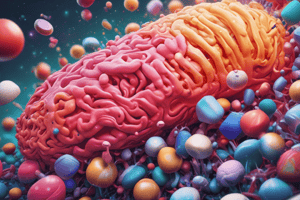Podcast
Questions and Answers
Which of the following is NOT a common adverse effect associated with quinidine?
Which of the following is NOT a common adverse effect associated with quinidine?
- Gastrointestinal effects
- Central nervous system effects
- Hepatotoxicity (correct)
- Increased risk of dysrhythmias
What is the primary mechanism of action for organic nitrates, such as nitroglycerin?
What is the primary mechanism of action for organic nitrates, such as nitroglycerin?
- Direct vasodilation of veins to decrease preload (correct)
- Inhibition of angiotensin-converting enzyme
- Inhibition of platelet aggregation
- Stimulation of adrenergic receptors to increase heart rate
Which of the following is a unique adverse effect associated with quinidine?
Which of the following is a unique adverse effect associated with quinidine?
- Lupus-like syndrome (correct)
- Orthostatic hypotension
- Anorexia
- Headache
What is a significant drug interaction associated with quinidine?
What is a significant drug interaction associated with quinidine?
Which population is quinidine considered a first-line treatment for?
Which population is quinidine considered a first-line treatment for?
What is the primary mechanism of action of calcium channel blockers (CCBs)?
What is the primary mechanism of action of calcium channel blockers (CCBs)?
Which of the following is a common therapeutic use of calcium channel blockers?
Which of the following is a common therapeutic use of calcium channel blockers?
Which of the following is a common adverse effect associated with the use of calcium channel blockers?
Which of the following is a common adverse effect associated with the use of calcium channel blockers?
Which specific calcium channel blocker is known to primarily affect the heart rather than the vasculature?
Which specific calcium channel blocker is known to primarily affect the heart rather than the vasculature?
Which class of drugs is considered a second-line option for the treatment of hypertension compared to calcium channel blockers?
Which class of drugs is considered a second-line option for the treatment of hypertension compared to calcium channel blockers?
Which of the following best describes the mechanism of action of ACE inhibitors?
Which of the following best describes the mechanism of action of ACE inhibitors?
Which class of drugs is known for causing a dry, irritating cough as a side effect?
Which class of drugs is known for causing a dry, irritating cough as a side effect?
Which of the following therapeutic uses is NOT associated with ACE inhibitors or ARBs?
Which of the following therapeutic uses is NOT associated with ACE inhibitors or ARBs?
Which of the following is a potential drug interaction with ACE inhibitors?
Which of the following is a potential drug interaction with ACE inhibitors?
Which of the following statements regarding ARBs is correct?
Which of the following statements regarding ARBs is correct?
Which of the following is the primary mechanism of action for ACE inhibitors?
Which of the following is the primary mechanism of action for ACE inhibitors?
Which of the following is a common adverse effect associated with ACE inhibitors?
Which of the following is a common adverse effect associated with ACE inhibitors?
Which of the following ACE inhibitors is specifically mentioned for use in diabetic nephropathy?
Which of the following ACE inhibitors is specifically mentioned for use in diabetic nephropathy?
Which of the following drug classes has a lower risk of cough and angioedema compared to ACE inhibitors?
Which of the following drug classes has a lower risk of cough and angioedema compared to ACE inhibitors?
Which of the following statements about aldosterone antagonists is correct?
Which of the following statements about aldosterone antagonists is correct?
Flashcards are hidden until you start studying




